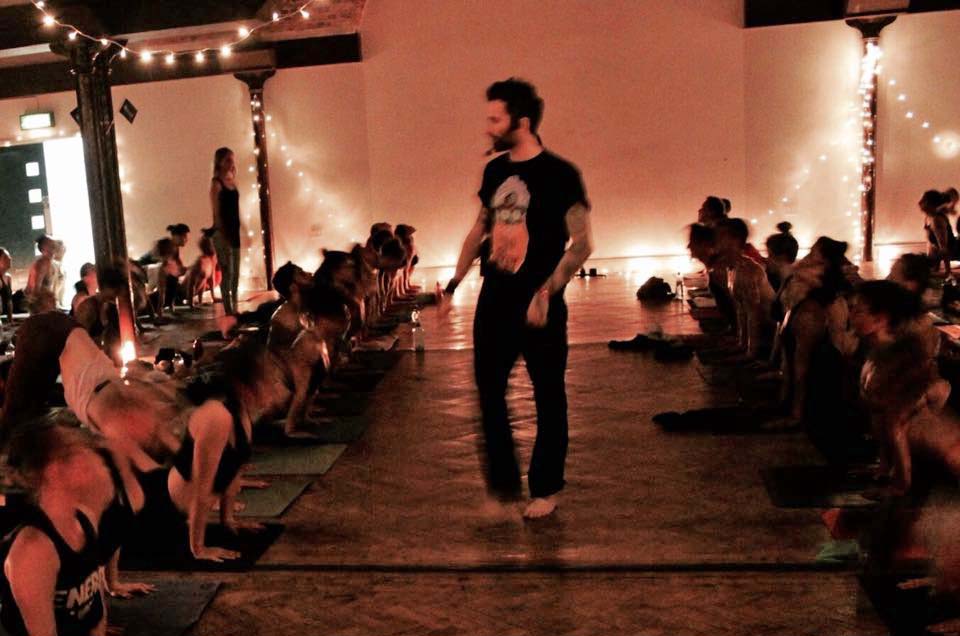
It’s a wet, winter night and we’re stood in an excitable queue, waiting to get into the crypt on Clerkenwell Green. A decade (or two) ago, I’d have been similarly lined-up in the darkness just around the corner from here, preparing to descend into the sweaty communal madness of the Turnmills (RIP) dancefloor.
Tonight we’re here to do yoga. But these seemingly parallel universes have more in common than just their subterranean EC1 locations. India’s ancient system connecting breath and body posture has, in fact, been busy colliding with club culture for some time.
And what’s particularly fascinating is the number of DJs who have become full-blown yoga teachers, including the man behind tonight’s event, one half of party-starting DJ duo The Loose Cannons, now better known as a leading proponent of the Rocket style of dynamic yoga, Marcus Veda.
This is Dead Yogi’s Society, his ambitious event series in aid of mental health charity MIND, a meeting of heavily perspiring likeminded souls, all losing themselves through physical movement to a carefully sequenced soundtrack, in a darkened room. Sound familiar, ravers?
LOCAL ADVERTISING
“It’s a bit of a cliché to say you can get out of your head without the drugs on a yoga mat,” says Marcus, “but when you sync the breath and everyone starts moving together in a pure flow state, that energy is so primal it taps right into that same thing you get from clubbing, blissing out dancing to that four-to-the-floor beat.”
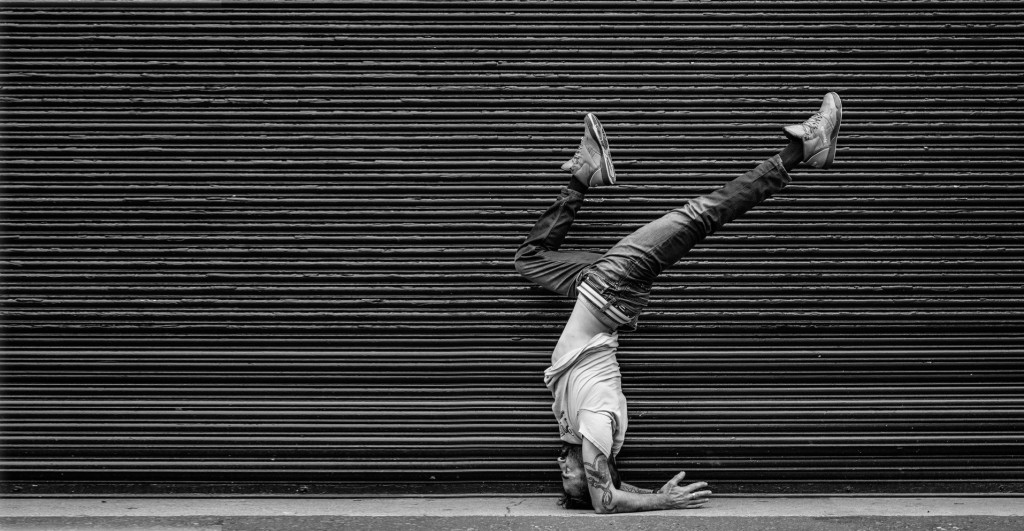
For those that are drawn to manipulating the energy of a crowd by mixing tunes, it isn’t hard to see the attraction of doing the same thing through guiding movement, particularly if there’s a musical element to a class as well.
“There’s still a perception from the general public that we’re doing something like the kind of gentle practice your aunt was doing in a village hall in the 1970s,” says Marcus. “But once they realise the dynamic styles aren’t like that, it opens up all sorts of possibilities.”
On-time resident at Turnmills’ hedonistic after-hours institution Trade, DJ Smokin Jo (aka Jo Josephs) has recently qualified as a teacher too.
“As a DJ, you’re taking people on a journey with the music, changing moods, creating a vibe,” she says, “and it’s the same in yoga, with asana and sequencing things in a way that can take people out of themselves, so to speak. Using music during the class lends itself really well to this. For me, one of the most exciting things about teaching is actually making my class playlists.”
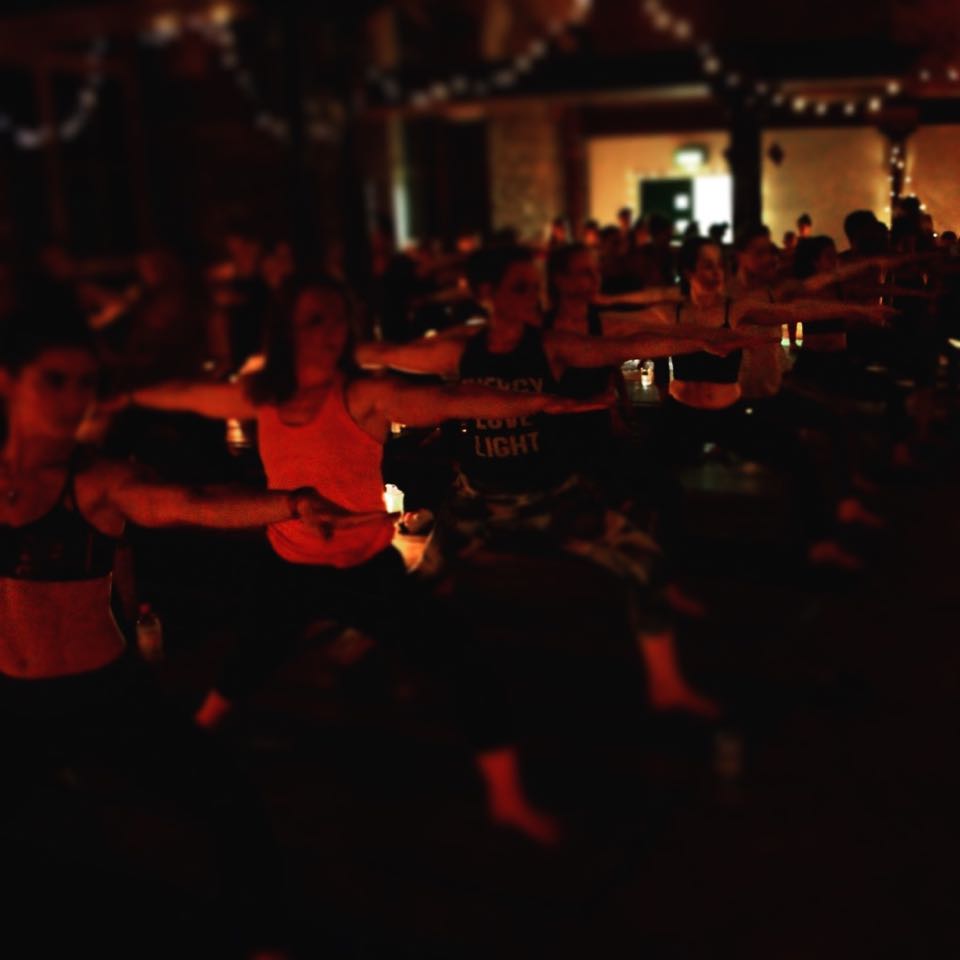
Down in the crypt, candles and fairy lights flicker as over 100 of us swan dive down into the darkness of the floor in unison. Marcus’ carefully planned soundtrack drops to a single, metronomic beat.
As the movement of bodies begins to heat up the vaulted brickwork room, the music expands and builds gradually, driving us forwards. It’s clear a huge amount of thought and timing has gone into these musical transitions.
“I make about half the tracks specifically for my classes,” Marcus tells us. “I don’t like ‘yoga music’ as it always ends up being a sitar over a bad trip hop beat or some dodgy chanting. From a musical point of view that doesn’t do it for me. But it’s not just about putting all the tracks that you like in a row either. In the same way DJs who just play for themselves are always boring, you’ve got to think carefully, go back and tinker with the mix if you feel the energy of the class shifts when a tune comes in a bit too heavy. And often I just want to distil it down to a beat.”
For a seasoned clubber, the way Veda sequences his yoga ‘sets’ is a bit of a revelation, particularly if you’ve experienced classes where the teacher fiddles with an iPhone and blasts out a jarring combination of reggae swerving into whale noises.
“The problem is that you now get yoga teachers becoming DJs,” he laughs, “at least the ones that were DJs in the first place know what to do.”
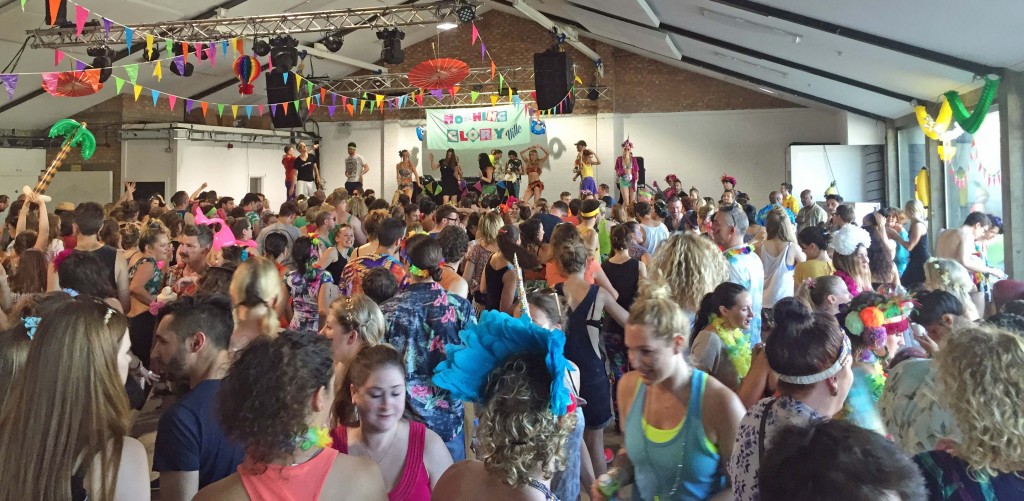
Only a few years back, yoga was much more purist and rigid. Breaking from the traditional systems was frowned upon, as was playing music. David Sye earned the tag ‘the bad boy of yoga’ for turning his YogaBeats classes into club-like parties, actively DJing while instructing.
Now it seems his ideas are mainstream, as a generation of people who grew up living for the weekend have found the mat offers a similar release from the daily grind, without the crushing hangover. The double drop now swapped for the downward dog, they are now collectively bringing party influences to the studio.
David has therefore upped the ante, introducing shots of tequila to some of his classes, which should ensure he continues to spark outrage. Meanwhile Marcus has DJed at a new wave of crossover events such as Black and Light, a Jivamukti style class where the mats are rolled up in the middle of the proceedings for a full-on rave.
And his former DJ partner Julien Davis now programmes the music at Morning Gloryville, the sober breakfast rave phenomenon – complete with yoga – that has been mocked for its hippy idealism, but undeniably makes the people on its dancefloors very joyful indeed. And they are always packed.
Jo Youle teaches JoGa Beats at the Samskara retreat in Ibiza, having formerly presented a dance music show on Brighton’s Juice 107.2 and been a music journo for BBC 6 Music. For her, the progression is an obvious one. “Throw a stone and you hit a DJ or a yoga teacher in Ibiza,” she says.
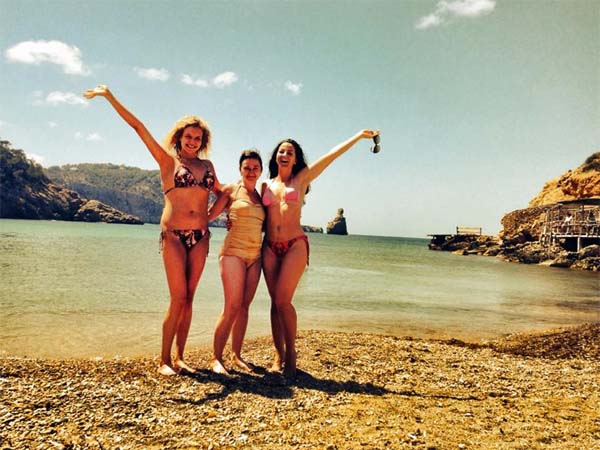
And it’s true that the island – that bristles with more yoga centres than it has world famous nightclubs – has done much to influence today’s dance music disciples in the restorative value of ancient Vedic tradition.
From her Ibiza base, Jo has brought yoga right onto the main stage at festivals including Bestival and Snowbombing, “where people often tell me that feels good to ‘check in, before you check out,’” she says.
“It’s a beautiful thing to see those who have never done yoga come to class at a festival. It shows them a slightly more conscious movement and sensation in their body before they go off and get totally smashed.”
Likewise, the practice can act as the ideal counterfoil to the rigors the Ibiza lifestyle. “I used to think the sofa was the best way to recover from clubbing,” says Jo. “That and a lot of crappy comfort food and maybe some more wine to take the edge off. Now I love to practice. A full power yoga class in the aftermath is a great way to sweat out the toxins, come back down to planet earth again and fully relax back into real life. Music can take you high and energy in Ibizan clubs can be wild, so yoga keeps us grounded.”
Fellow Ibizan yogi Smokin Jo agrees, “it is a high – almost a manic high – to do a great set in front of hundreds of people,” she says. “The high you get after yoga is much deeper, lighter and still, and it really helps balance out the crazy late night lifestyle.”
Drum and bass pioneer Goldie goes as far as to say his conversion to a daily Bikram practice saved his life. Swapping his more well-known addictions for a super-heated studio habit in recent years, he’s said “one of the main benefits for me was the internal and psychological effect of it clearing out my mind and defining my thoughts.”
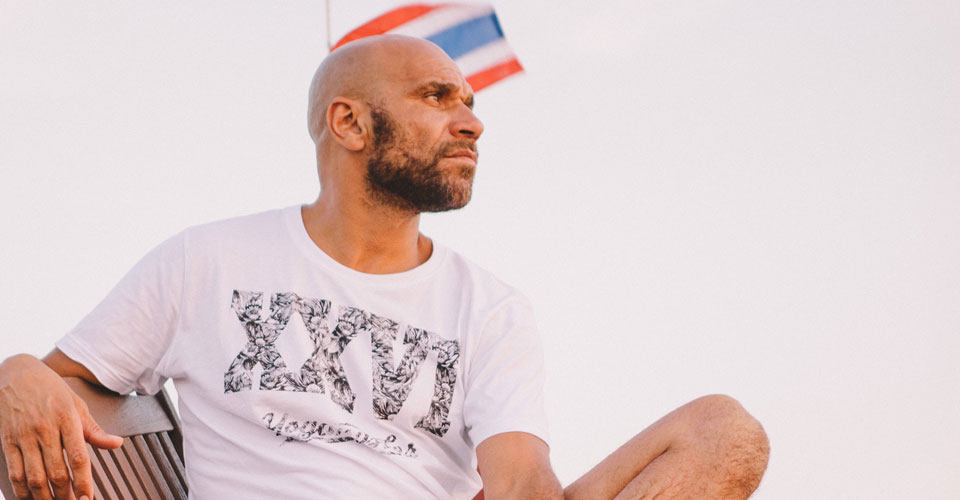
He’s become a bit of an evangelist for yoga, speaking on TV and appearing at trade shows, while establishing his own brand of performance clothing too, Yogangster. Although Goldie’s excesses have always swung to fairly extreme ends of the scale, his is a fairly common trajectory for creative types who have pushed things to the edge, and somehow worked out what to do next.
Rory Viggers ran Covent Garden’s seminal tech house emporium and label, Eukatech Records, but his yoga practice took over as vinyl sales tumbled, and these days he teaches six classes at week at YogaKutir in Bristol.
“I feel the essence of life is learning to tap into the happiness that exists within oneself,” Rory says, echoing Goldie. “With dance music, there is a culture of taking drugs and booze in order to create a hyperreal state of artificial or enhanced happiness. I got sucked into the cultural journey and all the mad stuff that went with it, and I had a blast. But as with anything you reach a peak and start to question it all. I realised that it’s perfectly possible to live in this natural state of happiness perpetually. Yoga is only one of many vehicles to attain this.”
DJing can be a lonely, soulless existence, the glamour often overshadowed by the reality of endless hotel rooms, airports and physically grinding antisocial hours. All this becomes particularly gruelling as one’s career advances, often forcing jocks to give up completely.
Rachel Auburn suffered a nervous breakdown as her DJ career swept her from life as a fashion designer on Leigh Bowery London’s Blitz club scene to a global touring success. She quit music, but found yoga.
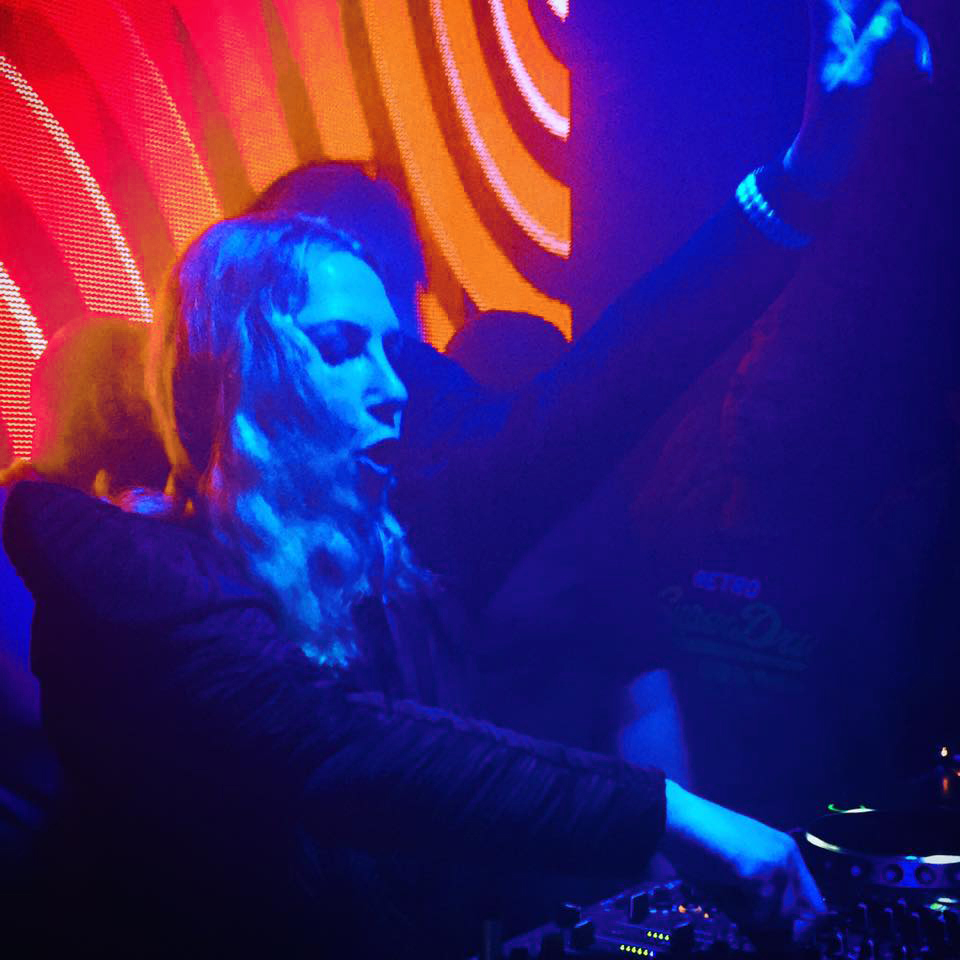
“When I fell apart I only had clubbing friends, taking loads of drugs getting out of their reality,” she says. “I didn’t understand meditation and was sceptical of psychology, but I read some Krishnamurti and decided to try yoga. It was long before today’s dynamic styles became popular, but I could see how similar it was to being a good DJ: controlling the room, being mother. Taking care of a whole group of people and transforming their energy in a positive way.”
For over 13 years she had no inclination to return to clubland, however she’s recently been convinced to mix a retrospective of fairly banging music from her long-running weekly DJ residency at Heaven, Reactivate: The Years 91-01.
Hearing those classic tunes again and dipping a toe back into the disco booth to play them, without the breakneck lifestyle, has been a curiously exciting experience for Rachel too.
“I’ve really enjoyed it,” she says, sounding slightly surprised. “But I know that a generation that started clubbing were transformed, and they still want to move their body, release the endorphins and feel completely ecstatic. I remember after a good night out everyone would be so positive, vibed up and feeling good, and it’s the same at the end of a class. The energy has changed.”
So while yoga offers many people a vital respite from a hectic existence, it’s the transformative power of both that is perhaps key to why it also shares an affinity with full-throttle 4am dancefloors.
“I used to bowl out of The Cross on a Sunday morning with steam coming off me, and see those around me, smiling, wet haired and wild eyed too,” say Jo Youle. “I still always think that’s how yogis should look when they come out of savasana at the end of a class.”
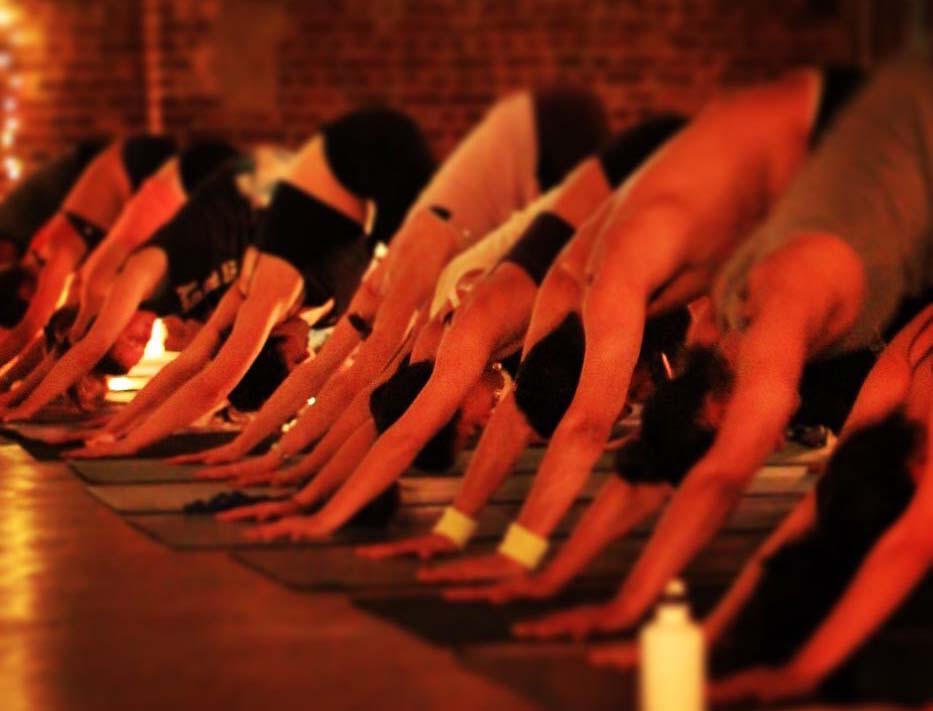
Back in the Clerkenwell crypt, we’ve achieved that beautifully dishevelled look, having attempted headstands, back-bends and thrown a variety of shapes, some of which are even intentional, by the time Marcus’ tribal rhythms ease down to a peaceful, atmospheric swirl.
His next charity event plans to push the boundaries further, with a ‘bath’ of sound created by five huge gongs played after the practice.
“From a DJ point of view it comes closest to the old Paul Oakenfold style of sonic tapestry,” he says. “Gong baths are the deepest thing I’ve got into since being completely out of my head of the dancefloor. A complete out-of-body experience.”
And he’s sure the crossover of club culture and yoga is only going to become more of a thing, so expect more of your favourite DJs to be dabbling in working unconventional floors of contorted limbs soon.
Having started his practice after a DJ stage-diving accident (say no more) it’s taken over Marcus’ life. “I’ve pretty much forgotten why I started,” he admits. “I guess it’s addictive and you want more. Suddenly find I don’t drink any more. I didn’t ever give up, I just don’t end up going out drinking. I’m too busy doing yoga.”


